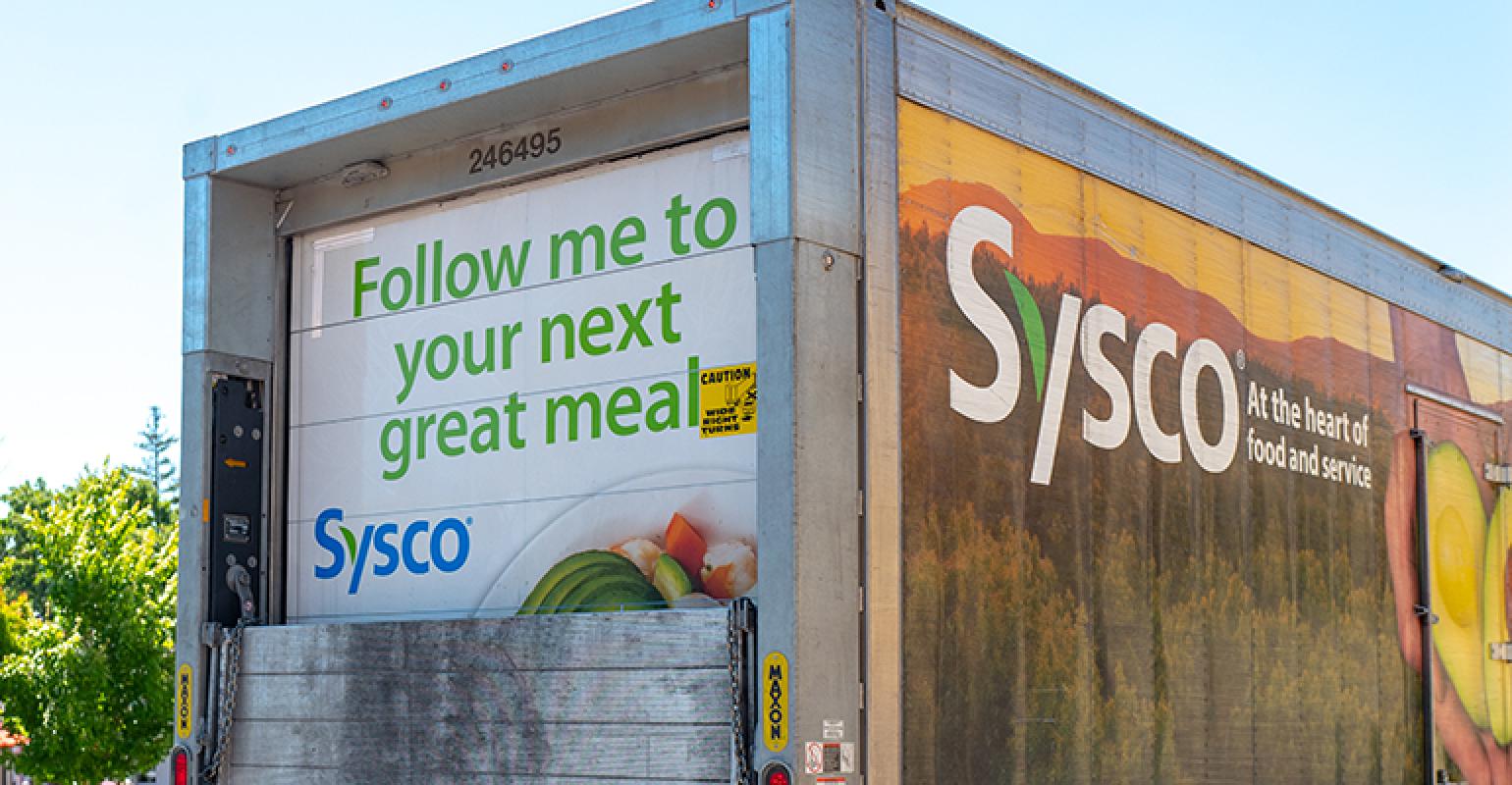Sysco Corporation, commonly referred to as Sysco, is a prominent American multinational corporation specializing in the marketing and distribution of various food products, smallwares, kitchen equipment, and tabletop items. Established in 1969 by Herbert Irving, John F. Baugh, and Harry Rosenthal, the company has since become a global leader in its field. Headquartered in the Energy Corridor district of Houston, Texas, Sysco serves a diverse clientele that includes restaurants, healthcare and educational facilities, hotels, inns, and other hospitality businesses. Additionally, Sysco provides wholesale services to foodservice companies such as Aramark and Sodexo.

Sysco operates more than 330 distribution facilities worldwide and serves approximately 725,000 customer locations. For fiscal year 2023, the company generated sales of more than $76 billion.
Sysco is a vital partner to the foodservice industry, helping its customers to succeed by providing them with a wide range of products and services at competitive prices. The company’s team of experts works closely with customers to understand their needs and provide them with the solutions they need to operate efficiently and profitably.
In addition to its core distribution business, Sysco also offers a variety of value-added services, such as culinary consulting, marketing support, and training programs. These services help customers to differentiate themselves from the competition and improve their bottom line.
Marketing Strategies of Sysco
Sysco Corporation employs a range of marketing strategies to effectively reach its target audience, cater to its diverse customer base, and maintain its competitive edge in the industry. Here are some key aspects of Sysco’s marketing strategies:
1. Customer Segmentation
Sysco Corporation uses customer segmentation as a marketing strategy to target specific groups of customers based on shared characteristics. Here are some ways in which Sysco segments its customers:
Geographical region: Sysco recognizes that the needs and preferences of customers vary depending on their location. To address this, Sysco has created regional divisions within its organization, each focused on serving the unique requirements of customers in their respective markets. For instance, Sysco’s Canadian division provides local produce, meat, seafood, dairy, and other ingredients specifically suited to Canadian cuisine and dietary preferences. Similarly, Sysco’s European division sources locally produced goods and develops menus tailored to regional tastes and cultural norms.
Industry type: As mentioned earlier, Sysco caters to clients across various industries. One example of this is Sysco’s “Culinary Connect” program, designed exclusively for chefs and culinary professionals. Through Culinary Connect, Sysco hosts events and workshops featuring renowned chefs who share insights and techniques related to menu development, plate presentation, and flavor pairings. These programs allow Sysco to build stronger relationships with its chef clients and position itself as a valuable resource for professional cooks.
Size of operation: Sysco acknowledges that smaller operators might require different levels of support compared to larger enterprises. To accommodate this, Sysco offers flexible ordering options through its online platform, “Sysco Online,” which allows customers to place orders at their convenience without having to commit to bulk quantities. Additionally, Sysco’s dedicated account managers assist small business owners in navigating complex regulations and compliance issues associated with running a foodservice establishment.
Purchasing behavior: Sysco leverages data analytics to track buying habits and identifies opportunities to upsell or cross-sell products to individual customers. For example, if a restaurant frequently orders premium steaks, Sysco’s account manager might suggest complementary items such as artisan breads, gourmet sauces, or high-quality desserts. By recommending relevant additions to existing orders, Sysco not only increases overall order value but also strengthens its relationship with the client by demonstrating a deep understanding of their business needs.
Demographics: Sysco recognizes that consumers’ values and preferences differ based on their age, gender, income level, ethnic background, and more. In response, Sysco collaborates with suppliers who prioritize sustainable sourcing practices, animal welfare standards, and fair labor conditions. By highlighting these attributes in its marketing materials, Sysco appeals to customers who seek socially responsible products while simultaneously supporting producers committed to those principles.
In conclusion, Sysco utilizes customer segmentation as an essential tool to deliver personalized experiences and solutions tailored to diverse customer needs. Whether it be through regional adaptations, industry-specific programs, flexible ordering options, data-driven recommendations, or socially conscious product offerings, Sysco effectively engages with its clients by understanding and addressing their distinct challenges and aspirations.
2. Product Portfolio Management
Product portfolio management refers to the process of organizing, evaluating, and adjusting a company’s offering of products or services to maximize profitability and meet consumer demand. Here are some ways Sysco Corporation implements product portfolio management as a marketing strategy:
New product development: Sysco continuously invests in research and development (R&D) to introduce new products that align with evolving consumer trends and preferences. For instance, Sysco launched its line of plant-based protein alternatives to cater to growing interest in veganism and vegetarianism. The company also offers gluten-free, allergen-friendly, and organic options to accommodate changing dietary restrictions and health concerns. By staying ahead of emerging market dynamics, Sysco can attract new customers and retain existing ones by providing innovative choices.
Product lifecycle management: Sysco monitors the performance of its products throughout their entire lifecycle, from introduction to eventual discontinuation. If a particular item underperforms or becomes obsolete due to changes in consumer taste or technology, Sysco will either revamp or remove it from its portfolio. Conversely, successful products receive continued investment in advertising, promotion, and distribution to maintain their popularity and generate long-term profits. By actively managing product lifecycles, Sysco ensures its portfolio remains fresh, competitive, and aligned with current market conditions.
Brand extension: Sysco leverages its established brand equity to launch new products that complement its core offerings. For example, the company introduced its “Sysco Simply” line, featuring all-natural, minimally processed, and ready-to-eat meal solutions. By expanding into adjacent categories, Sysco expands its potential customer base and generates additional revenue streams without compromising its reputation for quality and reliability.

By implementing effective strategies, such as new product development, lifecycle management, brand extensions, pricing tactics, distribution channel optimization, and customer feedback analysis, Sysco can create a well-balanced and profitable product portfolio that satisfies diverse customer needs and drives long-term success
3. Branding and Reputation
Branding and reputation are critical components of any business, including Sysco Corporation. A strong brand identity helps differentiate a company from its competitors while building trust and credibility among consumers. In this section, we’ll explore how Sysco leverages branding and reputation as part of its marketing strategy.
Consistent messaging: Sysco communicates a consistent message across multiple platforms, emphasizing its focus on foodservice expertise, product variety, sustainability, and customer satisfaction. Through social media, email newsletters, print ads, and website content, Sysco presents a coherent image that resonates with its audience. By consistently conveying its values and unique selling proposition, Sysco establishes itself as a reliable partner for businesses and individuals alike.
Visual Identity: Sysco has developed a recognizable visual identity, which includes its logo, color scheme, typography, and imagery. These elements appear consistently across different mediums, creating a unified look and feel that represents the company’s professionalism and attention to detail. The use of bold colors, clean lines, and modern design elements reflects Sysco’s forward-thinking approach and commitment to innovation.

Sponsorships and Partnerships: Sysco collaborates with organizations and initiatives that align with its mission and values. For example, the company supports culinary education programs, local farmers markets, and charitable causes related to hunger relief and environmental stewardship. By associating itself with these entities, Sysco demonstrates its dedication to making positive contributions to society, further strengthening its brand image.
By prioritizing authentic communication and meaningful engagement with its audience, Sysco fosters a positive brand image that sets it apart from competitors and builds lasting connections with customers.
4. Content Marketing
Content marketing involves creating and distributing relevant, valuable, and consistent content to attract and retain a clearly defined audience, ultimately driving profitable customer action (Source: Content Marketing Institute). As one of North America’s largest foodservice providers, Sysco leverages content marketing to educate, inspire, and connect with its various stakeholders, including chefs, restaurant owners, operators, and other industry professionals. Here are some ways Sysco uses content marketing as a marketing strategy:
Blog posts: Sysco operates several blogs tailored to specific segments within the foodservice industry. Its “Sysco Foodie” blog features articles covering topics such as menu trends, ingredient insights, kitchen tips, and industry events. Each post provides useful information, showcasing Sysco’s expertise and thought leadership in the field. Additionally, the blog encourages reader interaction through comments and social shares, facilitating community building around shared interests.
Social Media Presence: Sysco maintains active profiles on popular social media platforms like Facebook, Instagram, Twitter, LinkedIn, and YouTube. The company publishes visually appealing images and videos featuring recipes, cooking techniques, behind-the-scenes glimpses into food preparation, and interviews with renowned chefs. By curating engaging content, Sysco keeps followers engaged and interested in its offerings, promoting brand awareness and affinity.
E-books and Guides: Sysco produces comprehensive digital resources aimed at assisting foodservice professionals in their daily operations. Examples include “The Ultimate Guide to Food Safety,” “Menu Planning & Design,” and “Culinary Trend Forecast.” These e-books provide valuable insights, practical advice, and industry data, positioning Sysco as a knowledgeable and helpful partner. By offering free downloadable materials, Sysco generates leads and nurtures relationships with potential customers.
Video Series: Sysco has created original video series designed to entertain, inform, and inspire viewers. One notable example is “Fresh Cut,” a documentary-style program exploring unique restaurants and the personal journeys of talented chefs who run them. This series not only spotlights Sysco’s high-quality produce but also emphasizes the passion and creativity required to succeed in the hospitality sector. Other video series might focus on chef interviews, product demos, or event coverage, all contributing to Sysco’s diverse content portfolio.
In summary, Sysco’s marketing strategies are multifaceted and customer-centric. They focus on tailoring products and services to diverse customer segments, maintaining a strong brand reputation, leveraging digital marketing channels, and staying responsive to market trends and customer needs. Additionally, Sysco places a strong emphasis on sustainability and responsible business practices in its marketing efforts.
Marketing Mix of Sysco
Sysco utilizes the traditional marketing mix framework, also known as the 4Ps (Product, Price, Place, Promotion), to create a comprehensive strategy for marketing its products and services. Here’s a detailed breakdown of how Sysco applies the 4Ps:
Product
- Product Range: Sysco offers an extensive product range that includes a wide variety of food products, kitchen equipment, smallwares, and tabletop items. This range is constantly updated to align with industry trends and customer demands.
- Quality Assurance: Sysco places a strong emphasis on product quality and safety. They work with trusted suppliers and conduct rigorous quality control measures to ensure that the products meet the highest standards.
- Customization: Sysco tailors its product offerings to cater to the diverse needs of its customer segments. For example, they offer specialized products and services for restaurants, healthcare facilities, educational institutions, hotels, and other clients.
Price
-
- Pricing Strategies: Sysco employs various pricing strategies based on customer segmentation. They offer competitive pricing structures, volume-based discounts, and customized pricing arrangements to meet the specific budget constraints and purchasing patterns of their clients.
- Value Proposition: Sysco emphasizes the value it provides to its customers. They highlight factors like product quality, reliability, and the efficiency of their distribution network to justify their pricing.
Place
-
- Distribution Network: Sysco operates approximately 330 distribution facilities worldwide, which serve over 90 countries. This extensive distribution network ensures timely and efficient delivery to its customers, regardless of their location.
- Supply Chain Management: Sysco’s supply chain is a crucial part of their place strategy. They prioritize maintaining a well-functioning supply chain to minimize delays and disruptions in the distribution process.
Promotion
-
- Advertising and Marketing: Sysco employs various promotional techniques, including digital marketing, email campaigns, and traditional advertising channels, to reach its diverse customer base. They use these channels to showcase their product offerings, promote special deals, and share industry insights.
- Content Marketing: Sysco creates and shares content that provides value to its customers, such as recipes, culinary tips, and industry trends. This content not only promotes their products but also positions Sysco as an industry thought leader.
- Sales Promotion: Sysco runs sales promotions and special offers regularly, both through traditional advertising and direct communication with customers. These promotions are often tailored to specific customer segments or product categories.
It’s important to note that Sysco’s marketing mix is highly adaptable and flexible, allowing the company to cater to the unique requirements of each customer segment. Additionally, Sysco places a significant emphasis on customer relationships and responsiveness, often engaging in direct communication and account management to understand and address individual customer needs.
In summary, Sysco’s marketing mix strategy is built around offering a wide array of quality products, competitive pricing, efficient distribution, and a robust promotional effort that includes digital marketing and content creation. This comprehensive approach enables Sysco to effectively serve its diverse customer base in the foodservice industry.
STP (Segmentation, Targeting and Positioning) of Sysco
STP stands for Segmentation, Targeting, and Positioning, and it is a fundamental framework used in marketing to effectively define a company’s marketing strategy. Let’s break down the STP approach for Sysco with real-life examples:
Segmentation
Sysco utilizes several approaches to segment its markets and better understand the diverse needs of its customers. Here are some examples of how Sysco segments its markets:
Demographic Segmentation: Sysco categorizes customers based on demographic variables such as age, gender, race, religion, marital status, income, education, and occupation. For instance, Sysco might offer specialized menu options for vegetarians or people with gluten intolerance, or create kid-friendly meals for families dining out at restaurants served by Sysco.
Geographic Segmentation: Sysco takes into consideration the location of its customers when providing goods and services. The company acknowledges that regional differences in taste, culture, climate, and economic conditions impact food consumption patterns. Therefore, Sysco adapts its product portfolio, supply chains, and distribution networks to satisfy varying customer needs across different geographical regions.
Psychographic Segmentation: Sysco segments its customers based on their lifestyles, attitudes, interests, values, and personality traits. This approach helps Sysco tailor its marketing messages and offerings to match the preferences of specific customer segments. For example, Sysco might promote organic, sustainable, or plant-based products to health-conscious individuals or millennial consumers who prioritize social responsibility and environmental stewardship.
Behavioral Segmentation: Sysco segments its customers based on their past purchases, order frequency, spending patterns, channel preferences, and engagement levels with the company. By analyzing customer data and monitoring interactions through various touchpoints, Sysco identifies patterns and trends that inform its marketing strategies and tactics. For instance, Sysco might reward frequent customers with exclusive deals or personalized recommendations to encourage repeat business and foster brand loyalty.
Firmographic Segmentation: Sysco segments its business customers based on their industry, size, structure, and other organizational characteristics. This form of segmentation is particularly relevant for Sysco’s B2B operations since it serves many different industries, including hospitality, healthcare, education, retail, and more. Understanding the unique challenges faced by each industry and the procurement practices of companies within those sectors allows Sysco to develop customized solutions and build stronger relationships with its clients.
Benefit Segmentation: Sysco segments its customers based on the benefits they seek from using its products and services. This approach focuses on understanding why customers buy particular products rather than just what they buy. By identifying the underlying motivations driving consumer behavior, Sysco can craft compelling value propositions and communicate the benefits of its offerings more effectively. For example, Sysco may emphasize convenience, quality, variety, cost savings, or innovative solutions depending on the needs and expectations of different customer segments.
Targeting
Targeting refers to the process of selecting specific customer segments to whom a company will direct its marketing efforts and allocate resources. Sysco employs multiple targeting strategies to reach distinct customer groups and maximize its return on investment (ROI). Some of the key targeting approaches used by Sysco include:
Niche Marketing: Sysco targets niche segments characterized by unique needs, preferences, or behaviors. These segments often require tailored products, services, or communication channels to address their specific requirements. Examples of niche markets served by Sysco include schools, hospitals, senior living facilities, sports arenas, entertainment venues, and airlines. By focusing on narrow but profitable niches, Sysco can differentiate itself from competitors and establish strong relationships with high-value customers.
Mass Customization: Sysco strives to provide mass-produced goods and services that meet the diverse needs of individual customers. Through advanced technologies like 3D printing, digital manufacturing, and automated assembly lines, Sysco can efficiently customize products at scale while maintaining affordability and consistency. By offering personalized experiences without sacrificing efficiency or economies of scale, Sysco can attract a broader range of customers and enhance brand loyalty.
Multi-Channel Marketing: Sysco leverages multiple communication channels to connect with potential and existing customers. These channels may include traditional media like print, TV, radio, and billboards; digital platforms like websites, search engines, social media, email, and mobile apps; and experiential events like trade shows, conferences, pop-up stores, and sponsorships. By deploying integrated campaigns across multiple channels, Sysco ensures maximum visibility, relevancy, and resonance among its target audiences.
Positioning
Positioning involves creating a distinct and favorable image of the company and its products or services in the minds of the target customers within the chosen segments. Sysco positions itself as a reliable and quality-focused foodservice provider. Here are some examples of Sysco’s positioning:
Quality and Reliability: Sysco emphasizes its commitment to quality and reliability in all its marketing materials. They position themselves as a trusted source for high-quality food products.
Industry Expertise: Sysco positions itself as an industry expert by providing educational content, culinary tips, and insights into the latest food trends. This positions Sysco as a valuable resource for its customers.
Customer-Centric: Sysco positions itself as a company that is dedicated to meeting the unique needs of its customers. Their account management and customer service teams are integral in reinforcing this positioning.
In conclusion, Sysco effectively uses the STP framework to segment its market, target specific customer segments, and position itself as a quality-focused, customer-centric foodservice provider. This approach allows Sysco to meet the diverse needs of its customers across various industries and regions.
Also Read: The Glorious History Of SYSCO Corporation
To read more content like this, subscribe to our newsletter



